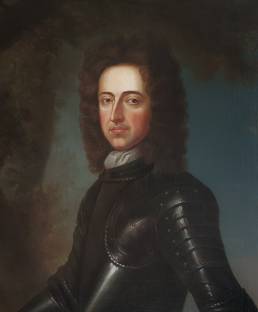Recently a contemporary painting of King William was sold at private auction in London. The portrait Of King William III is dated C.1700; the unknown artist appears to be a follower or in the Circle Of Sir Godfrey Kneller (1646-1723). What is most interesting about the portrait was its provenance includes the detail that it once hung in Dublin Castle until the late 1880s.
Description
Portrait of King William III when Prince of Orange c.1700, oil on canvas
Follower or Circle of Sir Godfrey Kneller (1646-1723)
This grand scale portrait painted circa 1700 depicts King William III, when William of Orange (Prince of Orange) on the battlefield, possibly during The Glorious Revolution. It is the epidemy of the early propaganda portrait. Images such as this were an essential tool that King William and his supporters used to emphasize and glorify his importance and further his cause. As such many were created and there were as many different variations. Painted in warm tones the sitter has been depicted with a straightforward and honest manner. The work is reminiscent of Sir Godfrey Knerller and Willem Wissing and is very impressive in quality and scale. The portrait was at Dublin Castle before it was sold to the Domville family of Santry Court, Dublin sometime before 1888.
Charles II died in 1685 and James became King James II and many in Protestant England were deeply suspicious of the new Catholic monarch. When his wife gave birth to a son it confirmed their worst fears of a Catholic succession. This meant that Mary was no longer next in line to the throne. Alarmed by the situation, a group of James’s Protestant opponents secretly invited William to invade England and oust his father-in-law. William’s mighty invasion force landed in Devon in November 1688. Many Englishmen supported William and, after some prominent English nobles defected to the invader, James II chose not to fight. He was subsequently captured and then allowed to escape to exile in France.
Early in 1689, the English Parliament formally offered William and Mary the throne as joint monarchs. The new monarchs could not rule with the same power as previous monarchs enjoyed. They accepted Parliament’s ‘Declaration of Rights’ (later called ‘Bill of Rights) which restricted the king’s power and marked an important transition towards the system of parliamentary rule that exists to this day. Later that year James landed in Ireland with French troops supplied by William of Orange’s sworn enemy, Louis XIV. In response William raised a huge invasion force, the largest Ireland had ever seen, and he decisively defeated James at the Battle of the Boyne. In Europe, William was successful in his lifelong struggle to contain the military ambitions of Louis XIV, the Catholic king of France. In part to help finance his wars with Louis, William founded the Bank of England.
Sir Godfrey Kneller (1646-1723) was born in Germany but trained in Amsterdam and studied in Italy before moving to England in 1676. Towards the end of the century, after the deaths of Peter Lely and John Riley, Kneller became the leading portrait painter in Britain and the court painter to English and British monarchs from Charles II to George I. He dominated English art for more than thirty years. His over 40 “Kit-cat portraits” and the ten “beauties” of the court of William III are most noteworthy.
Domville family, Santry Court, Dublin
Sale, Lawson and Broughton auctioneers, Sydney, 1888, where purchased by H.E. Lord Carrington
Accession Number
Unknown
Copyright/Ownership
Private Ownership
Location
Private Ownership




